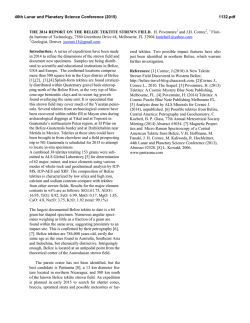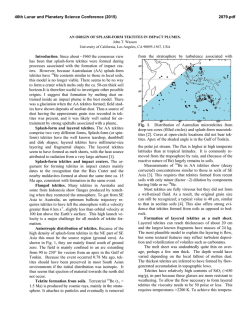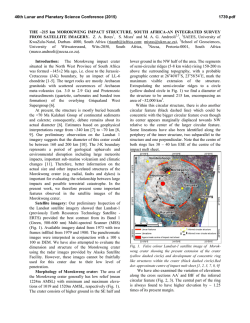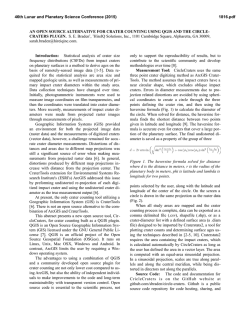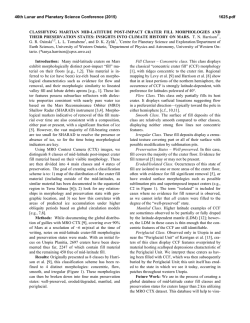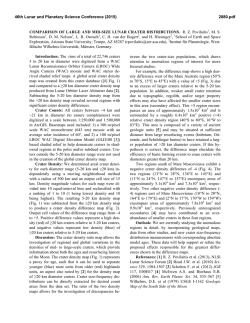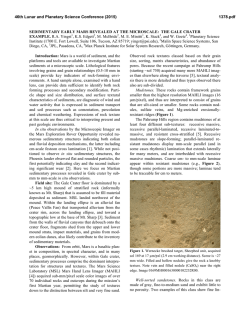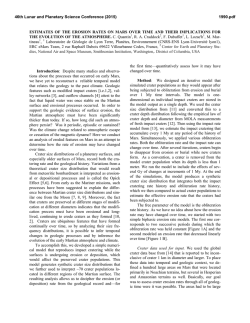
Tektite Observations and Suborbital Analysis. T. H. S. Harris1 and H
46th Lunar and Planetary Science Conference (2015) 1291.pdf Tektite Observations and Suborbital Analysis. T. H. S. Harris1 and H. Povenmire2, 1 Orbit Analyst and Propulsion Engineer retired, Lockheed-Martin (223 Union St. #1 Brooklyn NY 11231, [email protected] 718 344 6016), 2Florida Institute of Technology (7560 Greenboro Dr. #4, Melbourne FL 32904, [email protected]). Introduction: Tektites offer unique evidence of detailed impact process mechanics, although tektite formation mechanisms remain elusive. Tektite forming impacts are most likely very energetic (>20 gigaton TNT) [1], making them important to understand. Although the source crater for the largest known tektite strewn field remains unknown [2], the Australasian (AA) strewn field has expanded to include the Trans-Antarctic Mountains [3], the S. W. Indian Ocean [1], Southern China, and possibly two points in N. W. Canada [2,4] for an area on the order of 1/4 to 1/3 of Earth’s surface [2], making it the largest known strewn field. The Central American strewn field source crater also remains unconfirmed [4]. N. W. Canadian tektites need further confirmation as AA family, e.g. petrographic, Rb-Sr & Sm-Nd isotopic, etc. Discussion: Unexplained observations remain in the field of tektite study. Within the 786 ka AA strewn field alone such observations include: splash form tektites exhibit very high 10Be levels not accountable from the bolide or non-aqueous sediment [5] (although available from a vaporized or ionized ice sheet); the only known ablated tektites found in the ocean were within 20 centimeters of the top of the sedimentary column, one of which had a leeward surface impact spall from an impact after solidification and cooling (during free fall before reaching ocean surface?) [6]; layered tektites exhibit a lack of evidence of ablation [7]; microtektites are found in Antarctica at a range >10,000 km from the strewn field centroid [3, 8]; water content and 10Be content show some indication of systematic cross-variation by latitude and indicate a very wet formative environment [9]; and the estimated AA tektite mass is currently ~ 10 billion metric tons [1]. A 2.5 to 12 Gt fireball may produce orbital speed outflow (>7.9 km/s) above an atmospheric scale height and carry ~10 micron-scale particles to ~700 km altitude [10]. Outflow velocity above orbital velocity allows global transport. At 10 km/s launch velocity, an elevation of ~50 at ~285 azimuth puts you at MSN48G (S. tropical fall site) from a mid N latitude launch ~ 180 longitude away, or ~20 elevation at ~63 azimuth, with the former taking ~ 4 hr and the later taking ~7 hrs. 10 km/s is from australite button flange testing. AA tektite enigmas include thorough mixing of the microtektite melt with little or no volatilization [11], selective volatilization of layered tektites [11, 12], uniform Fe oxidation state throughout the strewn field although not the case with the N. American impact at Chesapeake VA, and a substantial lack of detectable bolide component within splash forms [11]. With Earth deep in the MIS 20 ice age at the time of the 786 ka AA event, ice sheet surfaces were extended. The Central European strewn field is associated with the Ries crater of excavated volume 124-200 km3 [13]. 2.5 g/cm3 density and 162 km3 gives ~ 6.6 x 1013 metric tons of excavated mass for Ries. The Ries tektite mass estimate is ~ 106 metric tons [14], for a crater-to-tektite mass ratio of ~ 6.6 x 107:1. Applied to the AA case, this estimate gives an excavated mass of ~ 6.6 x 1017 metric tons or ~ 660 times the mass of Earth’s atmosphere believed to be ~ 5.1 x 1015 metric tons [15]. Yet the AA crater remains unfound. Global atmospheric transient is a dominant guideline for AA tektite transport and trajectory analyses. Vertical plume outflow velocity at orbital speeds and Earth rotation during the many hours of such a global atmospheric transient should clearly yield intercontinental tektite transport. Recently identified Central American tektites in Belize and Guatemala are coeval with the AA tektites within precision of measurement, with different silica content from the AA family [16]. A layered tektite has now been identified in that horizon in Belize [16]. Is there a missing Central American crater? The Lake Bosumtwi and North American tektite impacts are examined for their own observations, and a comprehensive list is generated from the known tektite strewn fields. Volatile target overburden, oblique impact, bolide definition, gas/plasma dynamics and Orbit Analysis are considered in light of tektite observations. The centroid of a strewn field does not have to coincide with the crater at all geographically for large impacts, especially those with significant volatile target component. Historic tektite trajectory analyses are constrained by ablation-derived flight angle values close to horizontal [17,18] or by a minimum energy assumption as was common practice in the 1960’s, the era of ICBM development. Atmospheric entry velocity derived by tests to recreate flange button flattening of ablated tektites [18] and other constraints are considered in light of recent hypervelocity impact test findings. Summary and Conclusion: Automated Orbit Analysis software helps identify candidate geographic source crater regions via kinetic imprints which match 46th Lunar and Planetary Science Conference (2015) specific conditions of directional hypervelocity impact test results for some azimuth. Candidate crater regions must then be examined closely for gravimetric and magnetic anomalies, shock metamorphism, meteoritic component and associated gradient, and other impact signatures within the geologic record [19] consistent with tektite observations, the hypervelocity test scenario and target definition. References: [1] B. P Glass (1982) GSA Special Paper 190, 251-256. [2] Kenkmann et al. (2004) 77th Meteoritical Soc. Mtg., pdf 5322 [3] L. Folco et al. (2007) Geology v. 36 no. 4, 291-294. [4] H. Povenmire (2012) 75th Meteoritical Society Mtg., 5016. [5] D. K. Pal et al. (2002) Science vol. 218 [6] B. P. Glass & D. R. Chapman (1995) LPS XXVI Abstracts, 467-468. [7] B. P. Glass, personal communication. [8] B. P. Glass 1291.pdf and C. Koeberl (2006) Meteoritics and Planetary Sci. 41 no. 2, 305-326. [9] Watt et al. (2011) Meteoritics and Planetary Sci. 1-8. [10] E. M. Jones and J. W. Kodis (1982) GSA Special Paper 190, 175-186. [11] C. Koeberl (1994) GSA Special Paper 293, 133-147. [12] G. S. Ridenour (1986) Meteoritics, Vol. 21 No. 3. [13] R. Grieve (1982) GSA Special Paper 190, 25-37. [14] M. Trnka & S. Houzar (2002) Bulletin of Czech. Geo Survey no. 4, 283-302. [15] F. Verniani (1966) Journal of Geophysical Research, vol 71 issue 2, 385–391. [16] Hal Povenmire, personal communication. [17] J. S. O’Keefe III et al. (1973), Journal of Geophysical Research, v. 78 no. 17, 3491-3496. [18] D. R. Chapman (1964) Geochemical Et Cosmochimica Acta N6431571. [19] M. Davias (2010) Geo. Society of America ann. mtg. 116-13. Strewn Kinetic Profile: Normalized to Earth escape KE, a solution family is defined by strewn field and (proposed) astrobleme location or region. Example hypervelocity impact test trend identified within, lower right pane.
© Copyright 2025
